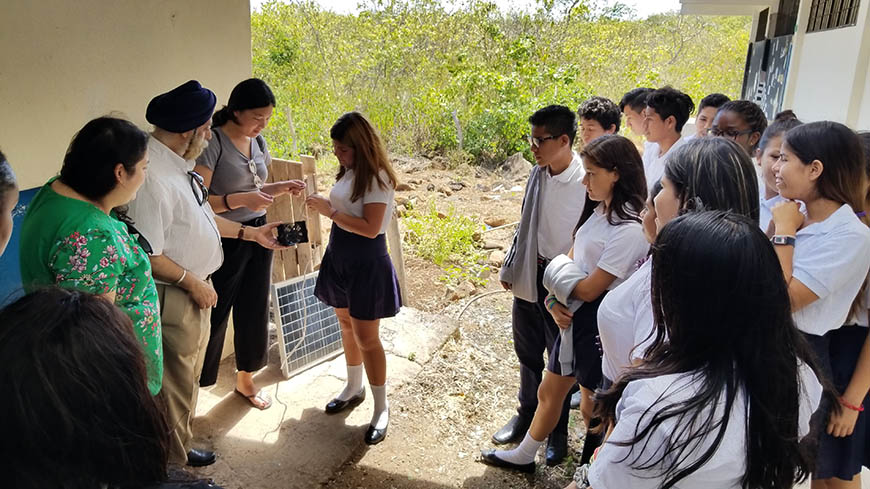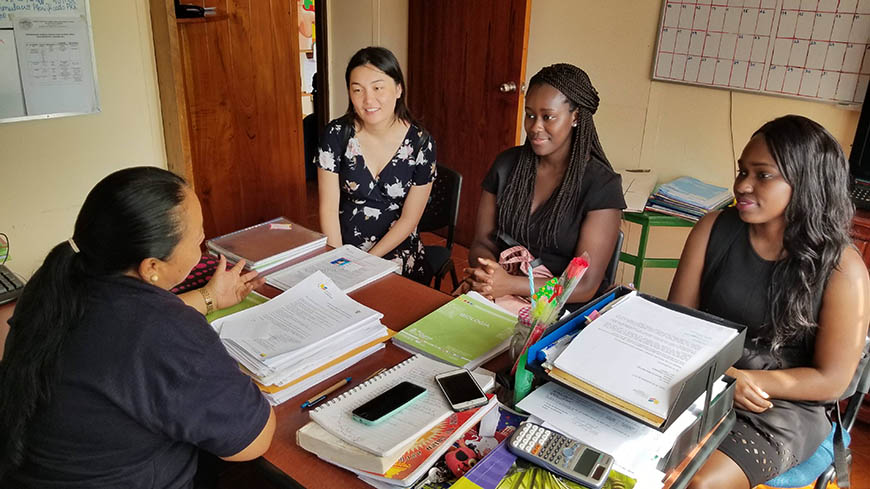Villanova Engineers Partner with Ecuadoran University to Create Intranet Solutions for Galapagos Island Schools

Dr. Pritpal Singh and undergraduate Sarah Chen taught students at the Ignacio Hernandez school about solar energy.
In May, 2018, Dr. Pritpal Singh, professor of Electrical and Computer Engineering, traveled to the Galapagos Islands with two Villanova University graduate students, three rising Computer Engineering seniors and Dr. David Lansdale of the Beyond Chacay Foundation. Working with Escuela Superior Politécnica del Litoral (ESPOL) in Ecuador, with whom Villanova has a signed memorandum of understanding, their mission was to investigate the potential for a community intranet to share sustainable education resources among schools on the Island of San Cristobal, where internet service is unavailable. In October, Villanova and ESPOL were awarded a $53,000 grant from the IEEE Humanitarian Activities Committee to proceed with the project.
The Galapagos Islands, located 1,000 km off the coast of Ecuador, are one of the world’s top ecological tourist destinations, and have been declared a UNESCO World Heritage site and a protected area for the islands’ biodiverse flora and fauna. Every year these islands receive a growing number of visitors, through a combination of cruise-based and land-based tourism. Since 2008, there has been a significant shift from cruises to community-based options, putting the environment at considerable risk due to the difficulty of monitoring these visitors in comparison to the carefully monitored cruise excursions.
According to Dr. Singh, “It is imperative that the youth on the islands are educated in sustainable development to protect these valuable natural resources.” The opportunity to provide free, shared resources through a community intranet will build on the existing Education for Sustainability initiative being successfully run through Ecuador’s Ministry of Education. The intranet also will allow schools, administrators and members of the community to communicate, providing a platform from which the current and future initiatives of the Ministry of Education can reach the extended community and more significantly impact the education sector. In essence, says Dr. Singh, “We want to close the digital divide, enhance collaboration and encourage the sharing of resources.”

Senior Computer Engineering majors Sarah Chen, Gibel Sowe and Karol Pierre discuss a computer lab and computing education curriculum with the principal of a local school.
Engineering students from Villanova and ESPOL will collaborate on the implementation of the WiFi network within the schools that will be used to share resources. They will also work with Elec Galapagos, the local electric utility company, to connect the local Wifi network to the optical fiber network. Finally, computer servers will be installed for storing educational resources and other tools, such as video conferencing software, to enable communication between teachers in the different schools (and for teacher training purposes).
In addition to Dr. Singh, several students from Villanova also will be engaged on the project, including PhD candidate Javier Urquizo, who came to the University from ESPOL where he had more than six years of experience working in renewable energy studies and the implementation of solar projects. Seniors Lauren Henderson, Gibel Sowe, Karol Pierre and Sarah Chen will also contribute through the technical design of the community network. The work will serve as the basis for their senior capstone design project.
“While the ultimate goal of the initiative is to connect all the schools on all of the islands, what is being proposed here is connecting the three high schools and three elementary schools on the island of San Cristobal as a pilot project to demonstrate the concept,” explains Dr. Singh. Once the pilot phase—which is expected to last eight months—has been successfully demonstrated, the system will be expanded to include all of the schools on the four inhabited islands.
